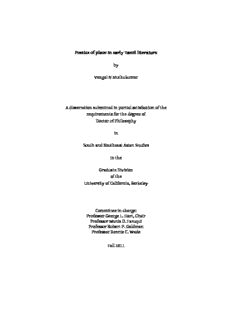
Poetics of place in early Tamil literature by Vangal N Muthukumar A dissertation submitted in ... PDF
Preview Poetics of place in early Tamil literature by Vangal N Muthukumar A dissertation submitted in ...
UC Berkeley UC Berkeley Electronic Theses and Dissertations Title Poetics of place in early Tamil literature Permalink https://escholarship.org/uc/item/8m87x6dg Author Muthukumar, Vangal N. Publication Date 2011 Peer reviewed|Thesis/dissertation eScholarship.org Powered by the California Digital Library University of California PoeticsofplaceinearlyTamilliterature by VangalNMuthukumar Adissertationsubmittedinpartialsatisfactionofthe requirementsforthedegreeof DoctorofPhilosophy in SouthandSoutheastAsianStudies inthe GraduateDivision ofthe UniversityofCalifornia,Berkeley Committeeincharge: ProfessorGeorgeL.Hart,Chair ProfessorMunisD.Faruqui ProfessorRobertP.Goldman ProfessorBonnieC.Wade Fall2011 PoeticsofplaceinearlyTamilliterature Copyright2011 by VangalNMuthukumar 1 Abstract PoeticsofplaceinearlyTamilliterature by VangalNMuthukumar DoctorofPhilosophyinSouthandSoutheastAsianStudies UniversityofCalifornia,Berkeley ProfessorGeorgeL.Hart,Chair Inthisdissertation,Idiscusssomerepresentationsofplaceinearly(ca. 100CE-300CE)Tamil poetrycollectivelycalledcaṅkamliterature. Whilepreviousresearchhasemphasizedtheim- portance of place as landscape imagery in these poems, it has seldom gone beyond treating landscape/placeassymbolicofhumanemotionality. Iarguethatthisapproachdoesnotad- dress the variety in the representation of place seen in this literature. To address this the- oretical deficiency, I study place in caṅkam poetry as having definite ontological value and somethingwhichisimmediatelycognizedbythesensesofhumanperception. Drawingfrom a range of texts, I will argue that in these poems, the experience of place emerges in a di- alogic between the human self and place - a dialogic which brings together sensory experi- ence, perception, memory, and varioussocio-cultural patterns; place, inthese poems, isnot asmuchanobjectivegeographicalentityasitistheprocessofperceptionitself. i िभ(cid:500)(cid:250) (cid:385)दय(cid:192)ि(cid:301)थद(cid:444)(cid:424)(cid:368)(cid:414) यि(cid:373)मि(cid:301)न(cid:101)त (cid:490)(cid:434)(cid:101)तः| जगौ परावर(cid:427) शा(cid:301)त(cid:427) त(cid:427) (cid:101)व(cid:500)ातीथ(cid:424)मा(cid:490)(cid:335)|| ii Contents Acknowledgments iii Anoteonabbreviations,translationandtransliteration iv 1 Introduction 1 2 Senses,Place,andSensesofPlaceinearlyTamilliterature 20 3 SensuousLandscapesintheParipāṭal 44 4 Soundscapes 68 5 Foodscapes 89 6 Someconcludingremarks 108 A Listofprimarysources 116 Bibliography 117 iii Acknowledgments Thisworkwouldnothavebeenpossiblebutforthehelpandsupportofferedbymany. I amthankfultothefollowingpeople. Tiru. Sampath and Tiru. Jayaraman, my Tamil teachers at Madras Christian College School; Prof. K.N.Balasubramanian, whotaughtmeTamilatA.M.JainCollege, Madras; my father S. Natarajan, uncles S. Thiagarajan and S. Pasupathy, and my brother N. Sivakumar, whofosteredmyinterestinTamilliteratureandliteraryhistory. Profs. A.A.Manavalan,S.RaghuramanandS.VenkataramanwithwhomIstudiedduring thelastcoupleofyears. Ithankthemfortheirtimeandsupport. Prof. GeorgeL.Hart,mythesissupervisorforhissupportduringmystayatUC,Berkeley. Profs. MunisFaruqui,RobertGoldman,GeorgeHartandBonnieWadewhoservedonmy Ph. Dqualifyingexamanddissertationcommittees. Ithankthemforreadingmydissertation carefullyandsuggestingseveralimprovements. Dr. SallySutherlandGoldmanandBrahmaśrī. VijayaraghavaSastri-mySanskritteach- ers; Tmt. Kausalya Hart whose Tamil courses at UC Berkeley gave me the time to read a va- rietyofTamiltexts;Prof. AlexandervonRospatt,Chair,DepartmentoftheSouthandSouth- eastAsianStudies,UCBerkeley,Prof. Y.V.SubbarayuluandTiru. M.KannanattheFrenchIn- stituteofPondicherryfortheirsupportandencouragement. The staff at the South and Southeast Asia Library at UC, Berkeley: Rebecca Darby- Williams,HudayaKandahjaya,AdnanMalik,VirginiaShih,andVanessaTaitforalltheirhelp duringmystayatBerkeleyandforprovidingoneofUC'sbestresources. MyfellowstudentsatBerkeley: SumitraRanganathanandAyonRoywhorecognizedthe phenomenologistin me and directed me to the literature on the phenomenology of percep- tion; Robbie Beahrs who provided several useful references on the anthropology of senses; Elizabeth Segran for conversations on caṅkam literature and for collaborating with me in translating some of the poems; Isaac Murchie and Michael Slouber whom I bothered not in- frequentlywithquestionsonSanskritgrammar,literatureandXeTeX. My old friend and TeXpert S. Venkataraman who has seen me go through all this once before-alongtimeagoandinadifferentcountry. Finally,mymotherSmt. Kameswari,auntSmt. Annapurani,cousinsMaheshandMouli whoheldthefortwhileIwasawol-notthatmypresencemakesmuchdifferenceastheywere quicktorealizeduringthelasttwoyears. iv List of abbreviations and a note on translation and transliteration Aiṅ. Aiṇkuṟunūṟu Aka. Akanāṉūṟu Cilap. Cilappatikāram Ciṟu. Ciṟupāṇāṟṟuppaṭāi Kali. Kalittokai Kuṟi. Kuṟiñcippāṭṭu Kuṟu. Kuṟuntokai Matu. Maturaikkāñci Mal. Malaipaṭukaṭām Naṟṟ. Naṟṟiṇai Pari. Paripāṭāl Pari. C.Comacuntaranar'scommentaryontheParipāṭal Parimel. Parimelalakar'scommentaryontheParipāṭal Pari. Ti. Paripātaṟṟiraṭṭu Perum. Perumpāṇāṟṟuppaṭai Poru. Porunarāṟṟuppaṭai Puṟa. Puṟanāṉūṟu Tiru. Tirumurukāṟṟuppaṭai Tol. Tolkāppiyam In transliterating Indic words, I follow the scheme suggested by the Library of Congress (http://www.loc.gov/catdir/cpso/roman.html). For ease of reading, I have chosen not to transliteratenamesofpeople(exceptwhentheyoccurinpoetryIquote). NorhaveItranslit- erated more common words ("Sanskrit", "Tamil", "Madurai", etc.). Some of the translations wereadaptedfromearlierworkdoneincollaborationwithElizabethSegran. Theseareindi- catedbyanasterix. Allothertranslations,unlessotherwisespecified,aremine. 1 Chapter 1 Introduction "சங்க நூல்களாகிய புதிய உலகத்தின் காட்சிகள் பனிமூடிய மைல ேபால் என் கண்ணுக்குத் ேதாற்றலாயின. பனிப்படலம் படர்ந்திருந்தாலும் மைலயினது உயரமும் பரு ைமயும் கண் ணுக்குப் புலப் படு தல் ேபாலத் ெதளிவாக விளங் காவிட்டாலும் அந்தச் சங் கநூ ற்ெசய்யுள்கள் ெபாருளை மதியினால் 'நிலத் தினும் ெபரியன வ ாகவு ம் வானிலும் உயர்ந்தனவாகவும் கடல் நீரினும் ஆழமுைடயனவாகவும்' ேதாற்றின." - உ. ேவ. சாமிநாத ஐயர், "என் சரித்திரம்", ப. 764 "Tomyeyes, thevistasofthenewworldofcaṅkamtextslookedlikeamountain shrouded in mist. But just as one is able to perceive a mountain's loftiness and vastnessdespiteitbeingcoveredbymist,byvirtueoftheirconnotationandcon- text,thepoemsfromthecaṅkamtexts-althoughIwasunabletounderstandthem clearly-appearedtomeas'widerthantheearth,higherthantheskies,anddeeper thantheseas'."-U.V.SwaminathaAiyar,eṉcarittiram,p. 764 This dissertation concerns the representation of place in the literature of the early Tamils - aliteraturewhichhascometobeknowncollectively,ascaṅkamliterature. Ofthisliterature, approximately2300poemsareavailabletoustoday,constitutingawealthofprimarysource material. Itshouldbeobviousthatnotallofitwaswrittenatthesametime,andthehistoryof thisliterature,itschronology,etc. havebeentopicsofconsiderabledebate. Foranexcellent summary of the vexatious dimensions these questions can acquire, I refer the reader to a recentessay by François Gros (Gros 2009). Fortunately, much of this debate is irrelevant for the purposes of my discussion which will be largely ahistorical. Here, I will merely note the widelyheldviewthatalargefractionofthecaṅkampoemswerecomposedbetweenthefirst andfourthcenturiesofthecommonera,withoutliersoneithersideofthistimeperiod. Whythespecificinterestinplaceandinwhatwaycanastudyofplaceinthesepoemscon- tributetotheexistingbodyofknowledgeoncaṅkamliterature? Itisgenerallywellknownin thefieldofearlyIndianliteraturethatlandscape/placeisanimportantingredientincaṅkam poetry. So much so, representations of landscape in this corpus of literature are often ad- ducedasevidenceforauniqueanddistinctliterarytradition(distinctfromtheotherclassi- calIndianlanguage,Sanskrit). However,whilepreviousresearchhasemphasizedtheimpor- tanceofplaceaslandscapeimageryinthesepoems,ithasseldomgonebeyondtreatingland- scape/placeassymbolicofhumanemotionality. Inthisdissertation,Iwillarguethatthisap- proachdoesnotaddressthevarietyintherepresentationofplaceemployedincaṅkamlitera- ture. Toaddressthistheoreticaldeficiency,Iproposeanewapproachinanalyzingthepoet- icsofplacebasedonavarietyofpoemsdrawnfromthecaṅkamcorpus. TheapproachIpro- 2 poseisbuiltonpredicatingplaceassomethingwhichisimmediatelycognizedbythesenses of human perception. Even a cursory reading of the caṅkam texts reveals that the protago- nists in the poems experience place in the most direct and immediate way - bybeing inthat place. Basedonthis,Iwillarguethattheexperienceofplaceinthesepoems,emergesinadi- alogic between the human self and place - a dialogic which brings together sensory experi- ence, perception, memory, and various socio-cultural patterns. In these poems, place is not asmuchanobjectivegeographicalentity,asitistheprocessofperceptionitself. Iwillbeginthisdiscussionbysummarizingsomebasicfeaturesofcaṅkamliteratureand thewaysinwhichpreviousresearchershaveengagedwithit.1 Thiswillalsogivemeanop- portunitytointroduceafewtermsandconceptsthatIshalluserepeatedlyinthisdissertation. Thefirstoftheseconcernsabroadclassificationofcaṅkamliterature: thepoemsinthiscor- pusareconvenientlyclassifiedundertwocategoriescalled"akam"and"puṟam". Manavalan notes that "... this classification is neither compilatory nor arbitrary, but thematic and tra- ditional (Manavalan 1977)." The words, "akam" and "puṟam" mean respectively, "inner" and "outer"-referringtotheinnerandouteraspectsofhumanexperience. However,inthecon- textofthiscorpusofliterature,"inner"isnotanyinnerexperiencebutrestrictedtolovebe- tweenmanandwoman. The"outer"dealswithwarfare,heroism,generosity,instruction,etc. Notwithstanding this binary classification, one often finds strands of akam in puṟam poems andviceversa. FollowingMarthaAnnSelby,itisperhapsbesttoviewakamandpuṟamas"two parallelsystemsbutwhosecomponentsoftenintersect(Selby2008)."Itshouldbenotedthat theseterms are definedin the normative Tamil grammar, the Tolkāppiyam (henceforth, Tol.) andnotinthepoemsthemselves. Thenextpointistonotethatmuchofthisliteratureisextremelystylized. Themes,situ- ations,andevenmetaphorscanallbeclassifiedreadily(astheyhaveindeedbeen). Asnoted byManavalan,intermsofbothsubjectmatterandpoeticmanner,"... thepoetryisgoverned bywell-codifiedprinciples... andthespiritandthetemperofthisliteratureistherefore,un- mistakablyclassical(Manavalan1975a)."Here,Manavalanpresumablyreferstothecodifica- tionfoundintheTol.,theearliestextantTamilgrammar. Whetherthistextprecededthepo- emsorotherwiseisagainaquestionwhichhasnotyetbeensettledconclusively.2 Butthere islittledoubtthatalmosteveryreadingofthesepoemsinthelastthousandyearshasbeenin- formedbytheTol. Thisisparticularlythecaseinthemedievalcommentaries-commentaries thathaveshapedcontemporaryunderstandingofthesepoems. Itisalsoevidentfromthepo- emsthemselvesthattheywerecraftedwithinaliteraryspacewhoseboundarieswerewellun- derstoodinpractice;inshort,thereiseveryreasonforustobelievethatthepoetswerefully awareofalargermatrixofideasfromwhichtheydrewtheirinspiration.3 Where and how does place fit in this discussion? The best way to begin answering this question is to turn to the akam poems, where some aspects concerning the representation of place have been well understood and discussed at some length in previous works. Most oftheakampoemsbelongtooneoffivepoeticsituationsrelatedtolove. Thefivesituations 1My discussion will be brief as these topics have been discussed by numerous authors. See for instance, Manavalan(1975a,b);Zvelebil(1973,1992). 2WiththeexceptionofafewTamilscholarssuchasVaiyapuriPillai,thisquestionhaspolarizedtheacademic communityalongpredictablelines,withmostTamilacademicsarguingfortheantiquityofthetextandmost Westernresearcherstakingtheoppositestance.Foradiscussion,seeTakahashi(1995). 3Itmaybearguedthatthisisbutanartifactofcompilation-thatthecompilersofthisliterature(ca. 4-7th centuriesCE)forcedacertainintegrityofstyle. Theargumentisvalidbutitdoesnotinanyway,mitigatethe factthatsomanyofthepoemssharethesameliteraryspace.
Description: